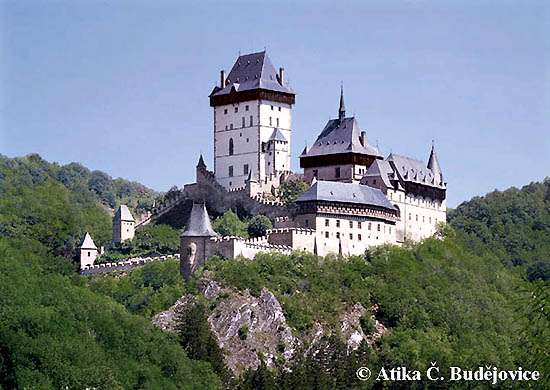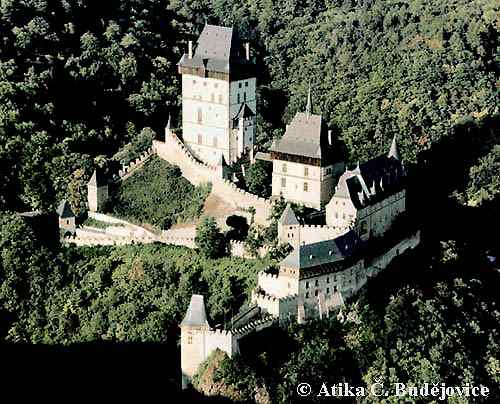Karlštejn
 Státní hrad Karlštejn, 267 18 Karlštejn
Státní hrad Karlštejn, 267 18 Karlštejn
Tel. +420 311 681 617, +420 311 681 695
e-mail: karlstejn@pusc.cz

The castle, exceptional even among the Czech castles, not only for its historical significance but also
due to its robustness and architecture. It was established by the Czech and Roman King Karel IV in 1348,
who gave it the role of the treasury for the coronation insignia and the most valuable relics of the Holy
Roman Empire. The basic construction of the Karlštejn castle took more than seven years, and the internal
adjustments of the Chapel of the St. Cross were prolonged until 1365. The castle fortification ought to
have resisted any attacks in its time, which was confirmed in 1422 when Karlštejn was besieged by Prague
citizens. By decree of the Caesar Rudolf II the damaged castle buildings were repaired at the close of
the 16th century but in spite of this a gradual deterioration of Karlštejn began just then. In 1619 the
coronation jewels together with the archives were taken away to Prague, in 1620 a garrison surrendered
the castle to the army of Ferdinand II without a fight and, in 1648, the castle was conquered by the
Swedes. The castle's deterioration continued through the 18th century, but the Hapsburg rulers were aware
of the historical significance of Karlštejn as well. Therefor the Caesar František II and his son
Ferdinand had the most seriously damaged parts repaired. After 1853 the supervision of this work was
taken over by a newly established Central Monuments Protection Commission residing in Vienna. Karlštejn
gained its present appearance under the purist adjustment works in 1887 - 1899 carried out to the designs
of professor Friedrich Schmidt by the architect Josef Mocker.

The individual parts of the castle are situated at the various height levels, which display their
significance. The castle is dominated by a massive prismatic tower, called Great, whose floor plan
consists of sides of 25 and 17 meters. The average wall thickness is 4 meters, reaching over 6 meters on
the northern side. The main space of this tower and the whole castle is occupied by the Chapel of St.
Cross. Along the lower part of its walls runs a strip of semiprecious stones embedded in a gilded stucco.
The vault fronts contain panels created largely by Master Theodorik, which are Gothic paintings of world
repute. The unique collection of about 127 paintings represents "the entire army of heavens", ideal or
approximate portraits of the saints, holy popes, and bishops, the Knights of the Theban League, holy
rulers and church teachers. These works were designed and predominantly painted by Master Theodorik, "the
Royal Court painter" of Karel IV. The chapel decoration is supplemented with mural paintings. The
vaulting is entirely gilded and covered with small pieces of glass, which represent a starry sky. In
connection with this exceptional space, though, we must add that access to the Chapel of St. Cross is
strictly supervised and that this interior is visited yearly by only a few percent of the total number of
the castle visitors.
Karlštejn impresses upon everybody with its stately manner and the same mood is communicated to
visitors by its interior, adjusted as closely as possible to the original Medieval appearance. It is
therefore possible along both of the tour routes to behold not only the architecture, which is uncommonly
valuable from a historical viewpoint, but also the furnishings approximately corresponding to those seen
by the Emperor Karel IV. Of the individual interiors it is, for example, the Ancestors' Hall with a
portrait gallery of the Czech kings, Banquet Hall, and royal bedroom, which can be marked out. The
moderately sized Chapel of St. Catherine in the Mariánská Tower excels with its valuable Gothic wall
decoration.

 Státní hrad Karlštejn, 267 18 Karlštejn
Státní hrad Karlštejn, 267 18 Karlštejn Státní hrad Karlštejn, 267 18 Karlštejn
Státní hrad Karlštejn, 267 18 Karlštejn

